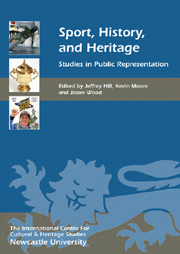Book contents
- Frontmatter
- Contents
- List of Illustrations
- Acknowledgments
- Sport, History and Heritage: An Investigation into the Public Representation of Sport – Editors' General Introduction
- HISTORY, HERITAGE AND SPORT
- MUSEUMS AND THE REPRESENTATION OF SPORT
- 7 Sport in Museums and Museums of Sport: An Overview
- 8 The Everton Collection: Unlocking the Value of a National Football Archive
- 9 Culture, Commerce, Capitalism and Commemoration: Dmitri Piterman and the Alavés Football Museum
- 10 Replacing the Divots: Guarding Britain's Golfing Heritage
- 11 Upping Our Game: The New Wimbledon Lawn Tennis Museum
- SURVIVALS AND LEGACIES: SPORT, HERITAGE AND IDENTITY
- Afterword: History and Heritage in Sport
- List of Contributors
- Index
- HERITAGE MATTERS
11 - Upping Our Game: The New Wimbledon Lawn Tennis Museum
from MUSEUMS AND THE REPRESENTATION OF SPORT
Published online by Cambridge University Press: 05 April 2013
- Frontmatter
- Contents
- List of Illustrations
- Acknowledgments
- Sport, History and Heritage: An Investigation into the Public Representation of Sport – Editors' General Introduction
- HISTORY, HERITAGE AND SPORT
- MUSEUMS AND THE REPRESENTATION OF SPORT
- 7 Sport in Museums and Museums of Sport: An Overview
- 8 The Everton Collection: Unlocking the Value of a National Football Archive
- 9 Culture, Commerce, Capitalism and Commemoration: Dmitri Piterman and the Alavés Football Museum
- 10 Replacing the Divots: Guarding Britain's Golfing Heritage
- 11 Upping Our Game: The New Wimbledon Lawn Tennis Museum
- SURVIVALS AND LEGACIES: SPORT, HERITAGE AND IDENTITY
- Afterword: History and Heritage in Sport
- List of Contributors
- Index
- HERITAGE MATTERS
Summary
INTRODUCTION
The analysis of sports museums by interested academics is on the increase, although the number of academic reviews of new museums or exhibitions remains limited, beyond the ‘Museum Reviews’ section of the Journal of Sport History (see, for example, Adair 2004; Alegi 2006; Brabazon 2006a; Brabazon 2006b; Brabazon and Mallinder 2006; Johnes and Mason 2003; Kohe 2010; Moore 2008; Osmond and Phillips 2011; Phillips 2010; Phillips and Tinning 2011; Ramshaw 2010; Vamplew 1998; Vamplew 2004). The publication in 2012 of a major edited volume by historians on the representations of sporting history in museums (Phillips 2012) is therefore welcome. Lacking, too, is much published self-reflection by the museum professionals concerned with interpreting sporting history. Short reviews in professional forums such as Museums Journal have to suffice. Yet museum displays, in sports museums and elsewhere, have long moved on from simply objects in cases and the ‘book on the wall’ approach to images and text. Museum exhibitions are increasingly sophisticated, technologically complex and based on extensive audience research. They typically involve scores of specialist contractors with a wide range of skills. A close consideration of the development of new museums can be useful to both the practitioner and the critic. This chapter is offered as a detailed examination of the process of creating the new Wimbledon Lawn Tennis Museum from my perspective as Curator.
- Type
- Chapter
- Information
- Sport, History, and HeritageStudies in Public Representation, pp. 161 - 180Publisher: Boydell & BrewerPrint publication year: 2012



